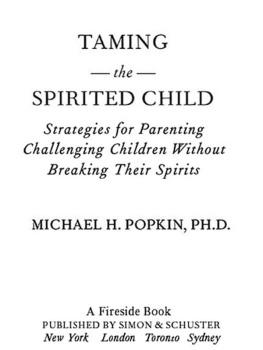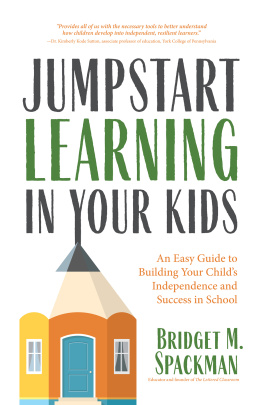Tanith Carey is an award-winning national newspaper journalist and writer on parenting and society for the Guardian, the Independent and the Daily Mail, among many other newspapers and magazines. She is also the author of six books three on parenting. Her previous book Where Has My Little Girl Gone? How to protect your daughter from growing up too soon, published in 2011, was the first hands-on guide for parents on how to handle the challenges of early sexualisation.
Praise for Where Has My Little Girl Gone?
Tanith Carey swims against the tide in this brilliant how to book. She is not a lone voice its time we as parents stood up to the esteem-robbing barrage our daughters face. As a parent of three daughters I encourage all mums and dads to read this book.
TV presenter Carrie Grant
An invaluable roadmap that will guide parents through the maze of modern-day adolescence, helping parents to bring out the best in their daughters. Full of practical and effective strategies read it and share it!
Nol Janis-Norton, Director of
Calmer, Easier, Happier Parenting
Well researched and sensitively written, this is both an important
book and a very useful tool for parents.
Dr Linda Papadopoulos, author of
the Home Office Review on the Sexualization of Girls
TAMING THE TIGER PARENT
Tanith Carey

Constable & Robinson Ltd.
55-56 Russell Square
London WC1B 4HP
www.constablerobinson.com
First published in Great Britain
by Robinson in 2014
Copyright Tanith Carey, 2014
The moral right of the author has been asserted.
All rights reserved.
No part of this publication may be reproduced, stored in a retrieval system, or transmitted, in any form, or by any means, without the prior permission in writing of the publisher, nor be otherwise circulated in any form of binding or cover other than that in which it is published and without a similar condition including this condition being imposed on the subsequent purchaser.
A CIP catalogue record for this book
is available from the British Library.
ISBN: 978-1-84528-549-4 (paperback)
ISBN: 978-1-84528-564-7 (ebook)
Typeset in Adobe Caslon Pro by PJM Design
Printed and bound in Great Britain by CPI Mackays
An Hachette UK Company
www.hachette.co.uk
CONTENTS
INTRODUCTION
J OHN WAS JUST FOUR days old when his mother Dana set about teaching him to read.
The fact that newborns cant focus on anything more than a few inches away let alone recognise words did not deter her. Dana was so evangelical in her belief that sooner is better that twice a day she ran through a set of ten flashcards with her firstborn son.
I would show John words like milk, give him my breast and then show him the baby sign language for milk, says Dana, a 41-year-old American businesswoman who had relocated to the UK. I did it every morning and evening. At first I did it so he would get familiar with the sounds and then so he could see the shape of the word.
Dana who moved on to teach John meditation and scientific plant classification says: Of course, when he was first born, I knew he couldnt see the words, but he could hear them and I thought it wouldnt do any harm.
By nine months, Dana says that John was pointing and using baby sign language to show he could recognise up to twenty words and phrases including I love you, nose, ear and arms up.
No matter that the programme Dana used, Your Baby Can Read, has been censured by consumer watchdogs for falsely inflating parents expectations. Or, that after sales of 112 million around the world in four years, the firm has now gone out of business after experts pointed out that there are just as many dogs as babies on YouTube who, when given a simple word, can correctly point to the right flashcard.
Like every mother, Dana simply believes she is doing the very best for her child. Its survival of the fittest, she explains without apology. I want to give my son every mechanism out there to get ahead of the pack. In eighteen years, John will be at either Yale or Oxford. Youll see.
In fact in todays increasingly cut-throat race for Oxbridge or the Ivy League, some might even consider that by waiting until Johns birth, Dana has left it a little late. We live in a culture where mothers go on pre-conception diets to boost brain power, and where ber-organised couples time the moment of conception precisely in order to give birth just after the 1 September cut-off date for schools.
Savvy parents know that, due to being the oldest in the school year, autumn babies are off to such a flying start that they end up twenty-five per cent more likely to get a place at Oxford or Cambridge. So perhaps its no coincidence that, over the last decade, September and October have been consistently among the three most popular months to give birth in England and Wales.
No sooner has sperm successfully met egg than mothers turn their wombs into their childrens first classrooms. Unborn babies become the captive audience for classical music blasted in utero in stereo before they even have ears. Once safely delivered, infants have barely drawn their first breath before parents are fretting about their Apgar scores. Under starters orders, the curriculum proper now begins: flashcards before infants can properly see, baby sign language classes before they can talk and baby swimming classes before they can walk.
Yet, extreme as it all sounds, when I interviewed Dana and dozens like her, I have to admit I understood where she was coming from. After all, I too had given birth in a culture where, from the moment the umbilical cord is cut, parents like me live with the constant fear that they can never do enough to make their offspring the brightest and best.
As the mother of two children, I will start this exploration into the causes and effects of tiger parenting by confessing that, like so many others, I too had succumbed to the message that child-rearing was a race. When my first daughter was born almost thirteen years ago, her future seemed mapped out. I approached my new role with more dedication than I would an MA. This was to be my ultimate test. For the sake of my daughter, I could not fail. If there was an enrichment programme, toy or book I could use to make my baby smarter, I would try it. I would play so much Mozart that the synapses in her tiny infant brain would fizzle and pop. I would breastfeed until she reached her optimum IQ.
In dismay, I looked back on my own childhood of benign neglect, complaining that I had simply been left to go and play as if that were tantamount to child abuse. Never mind that my happiest memories were of kicking the branches of the fir tree that hung above my garden swing and tapping the heads of frogs in the garden pond with sticks. All that was conveniently forgotten now that I had joined the educational arms race.
When my baby arrived in December 2001, all went to plan. I loved the way her eyes seemed to sparkle with amazement when I jiggled and turned her in her baby sling to look at works of art in museums and art galleries. At moments like those, I felt like the best mother in the world. After all, I was told there was not a moment to waste. The neural explosion in the brain, which started at conception, would abruptly stop at the age of three.
Soon my bookshelf groaned under the weight of books with titles like Make Your Child Brilliant and Bring Out the Genius in Your Child. On the first day at Montessori, I glowed with satisfaction when, while other toddlers dashed about, my daughter quietly sat down and arranged the right number of plastic pigs in the correct red circles. Navely, I assumed all my hard work had paid off.
Next page










